|
|
|
Sort Order |
|
|
|
Items / Page
|
|
|
|
|
|
|
| Srl | Item |
| 1 |
ID:
144561


|
|
|
|
|
| Summary/Abstract |
Energy, as a resource, has been considered only as a factor of complex geopolitical rivalries and geo-economic calculations globally. This article, on the other hand, attempts to analyse a parallel trend in the post-Cold War international scenario, a trend that shows how energy gains global relevance as a vector of alliance and a link for interdependence, and how economic and environmental challenges have become the compelling factors to push competitors to turn into allies and partners.
|
|
|
|
|
|
|
|
|
|
|
|
|
|
|
|
| 2 |
ID:
144560
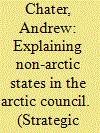

|
|
|
|
|
| Summary/Abstract |
How has the role of observers in the Arctic Council evolved and why is there increased interest in participation by states and international institutions? This article examines the influence and interest of observers in international institutions. The Arctic Council is an international institution founded in 1996 to promote Arctic environmental protection and sustainable development. Ultimately, observers are weak actors in the Council. Despite this weakness, actors seek to become observers for two reasons. First, actors seek to contribute to the governance of environmental issues of global importance. Second, actors strive to gain as states develop the economic potential of the Arctic region.
|
|
|
|
|
|
|
|
|
|
|
|
|
|
|
|
| 3 |
ID:
144562
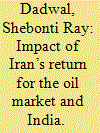

|
|
|
|
|
| Summary/Abstract |
As was anticipated, the nuclear sanctions imposed against Iran were finally lifted on January 16, 2016 after it was certified by the International Atomic Energy Agency (IAEA) that Iran had met its obligations under the Joint Comprehensive Plan of Action (JCPOA) reached in July 2015 among six world powers. The deal has not only allowed Iran access to the billions of dollars of assets in international bank accounts that were frozen during the sanctions period, but will also possibly see thousands of barrels of Iranian crude added to its current exports of 2.9 million barrels per day (mb/d), with the possibility of 1 million barrels extra per day (mb/d) by the end of 2016.
The announcement of the end to the sanctions regime imposed on Iran, has reiterated what the markets have been predicting for a while—that any recovery in oil prices will not be taking place till the end of the year at least, if not longer. But more importantly, what will it mean for the oil market in general and for the Persian Gulf oil-exporting states in particular at a time when the oil market is witnessing a 12-year low with prices that have dipped under $30 a barrel? Interestingly, despite the slump, demand has been tepid at best, contributing to the dismal price scenario. Given that the market was over-supplied by around one mb/d already, why did Washington allow Iran to return to the oil market at a time when the US oil sector was adversely affected by the low oil prices?
|
|
|
|
|
|
|
|
|
|
|
|
|
|
|
|
| 4 |
ID:
144563
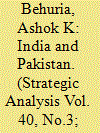

|
|
|
|
|
| Summary/Abstract |
Intelligence sharing by the Pakistani National Security Advisor (NSA) with his Indian counterpart in early March 2016 came up as an interesting outcome of the ongoing engagement between them since December 2015. Such exchange of critical information has raised the levels of expectation among the peaceniks in the subcontinent about the prospects of peace talks between the two countries, after a whole series of false starts since 2008.
Media reports in India termed it ‘unprecedented’1 and regarded it as ‘a new layer’ to India–Pakistan ties, while editorials in Pakistani English media hailed it as ‘timely, relevant and cooperative’, which could ‘clear the path for a full-fledged re-engagement’, and recommended that ‘regular interaction, sharing of information and mutual capacity-building will increase the trust between both governments—a key commodity severely lacking between the two neighbours’.
Does it indicate a change of mindset in the Pakistani military establishment and signal an ‘across-the-board fight against terrorism’ by the Pakistani state, as an editorial in the daily Dawn (March 10, 2016) (a leading Pakistani daily English newspaper) suggested? Is it aimed at changing the contours of the India–Pakistan relationship leading to a full-fledged resumption of dialogue or a minor flash in the pan? It is useful to closely analyse the development in light of the optimism that the report has engendered in India and Pakistan.
|
|
|
|
|
|
|
|
|
|
|
|
|
|
|
|
| 5 |
ID:
144564
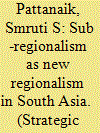

|
|
|
|
|
| Summary/Abstract |
India’s engagement with its neighbours received a policy reinvigoration after the National Democratic Alliance (NDA) government assumed power and announced its ‘neighbourhood first’ policy. The first sign of this policy was visible when Prime Minister Narendra Modi invited all the heads of state of the neighbouring countries for his oath-taking ceremony, on May 26, 2014. India’s interest and engagement with the South Asian Association for Regional Cooperation (SAARC) has also intensified in the past few years – from being a reluctant player to driving the regional economic agenda. Unlike in the past, Prime Minister Modi undertook his first foreign visit to Bhutan, followed by visits to Nepal, Sri Lanka, Mauritius, Seychelles and Bangladesh, to synergise bilateral relations. India had already intensified its cooperation at the regional and sub-regional levels and the NDA government was proactive in taking these engagements forward. Regional as well as sub-regional cooperation became major vehicles of India’s neighbourhood policy, at the core of which was the development agenda of the present government.
|
|
|
|
|
|
|
|
|
|
|
|
|
|
|
|
| 6 |
ID:
144559
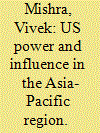

|
|
|
|
|
| Summary/Abstract |
Recently, the nature of the presence of the US in the Asia-Pacific has undergone significant changes. At least three developments—the rise of an economically and militarily resurgent China, a renewed counter-strategic approach by the US to rebalance its engagements with its close regional allies like Japan, the Philippines, South Korea and Australia, and the US’ efforts to expand and extend strategic cooperation with India and Vietnam—show that there are new emerging differences between the US and its four major non-NATO allies in the Asia-Pacific. These developments point towards declining strategic reciprocity of these nation states with the US and vice versa as they seek relative autonomy in their engagements with Beijing along with other extra-regional powers. While this has tacitly mandated the expansion of the US alliance system from the core Asia-Pacific region westwards to include the Indo-Pacific, the Indian Ocean and a few other Southeast Asian nations, it has also depicted the insufficiency of the US’ alliance with non-NATO allies in meeting its somewhat altered regional objectives since the turn of the century.
|
|
|
|
|
|
|
|
|
|
|
|
|
|
|
|
|
|
|
|
|